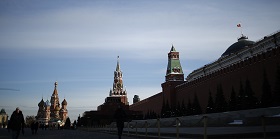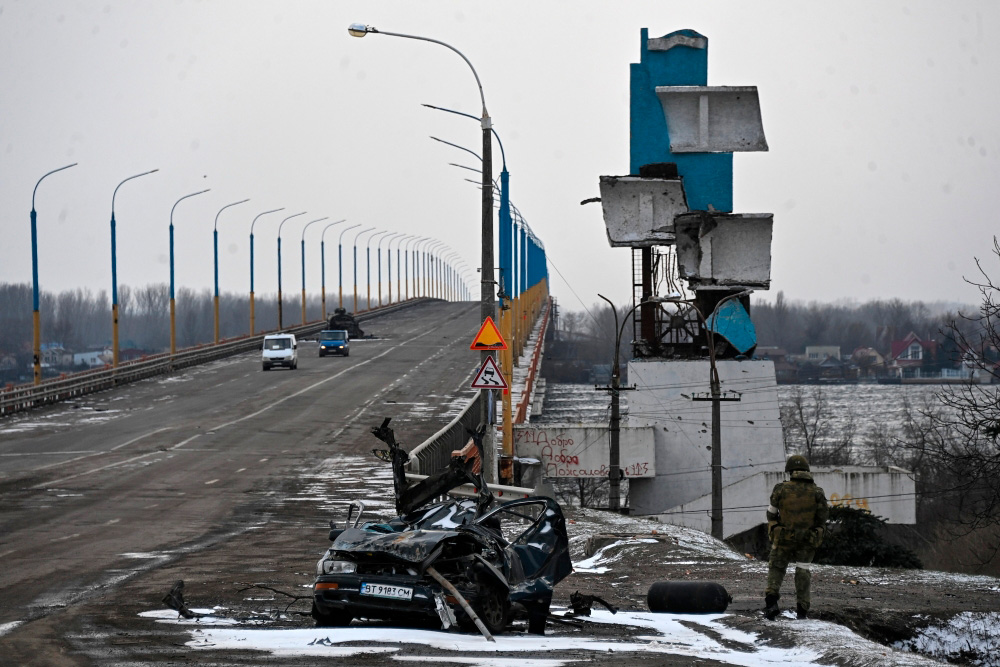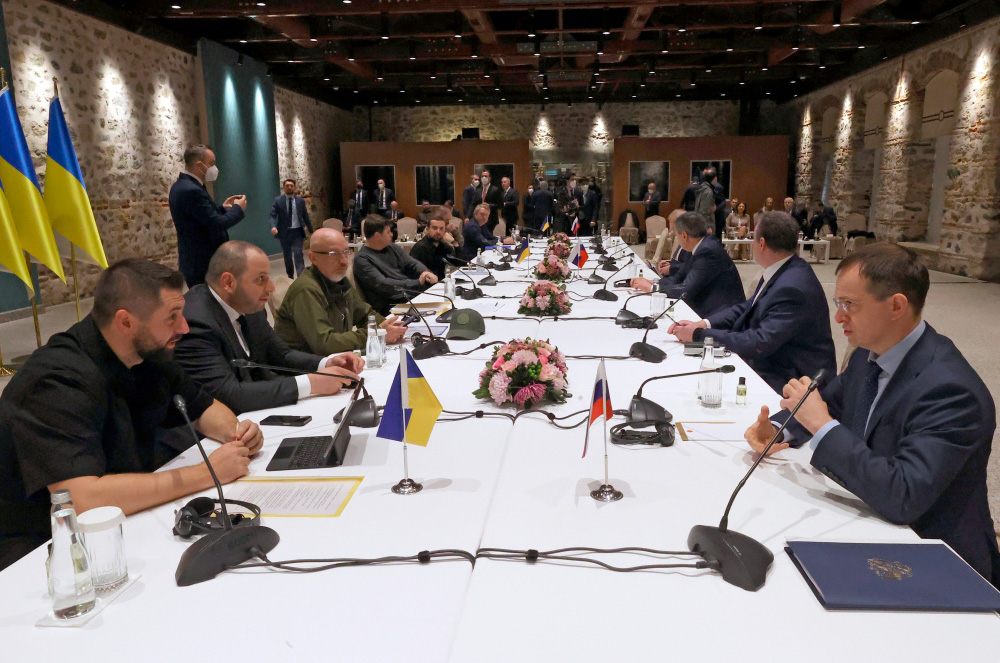The Ukrainian conflict has effectively overhauled the challenges and threats that Russia faces. We have had next to no such precedent in our history. The accumulation of shocks and their cumulative effect can impinge both on the society and on Russia’s statehood. There will be no going back, while scenarios of the future—previously considered highly unlikely—have emerged.
The uniqueness of the threat configuration paradoxically coexists with the standard nature of the set itself. From a historical perspective, until today, most of them could be divided into three baskets. Let’s call them the “Big Three”.
The first basket consists of external threats. Vulnerability to stronger neighbors is a sense peculiar to Russia’s political culture. The historical experience of numerous conflicts and the accumulated grievances of the long and recent past, along with existential security challenges, are commingled here.
The new paradigm of military and political pressure on Moscow is taking root for years to come. Historians will long argue about who is more to blame for the current crisis. However, something else is important. The military threat to Russia, the hostility of the West toward it, and, most importantly, the scope of specific actions to contain Moscow have multiplied.
The second basket includes the underdeveloped organization of the economy and public administration. For the last 500 years, Russia has systematically faced the task of modernizing its economy and institutions. Overcoming backwardness was often one-sided and unbalanced, although attempts to get rid of underdevelopment once and for all were repeatedly made since Peter the Great’s reign.
Large-scale Western sanctions have significantly exacerbated the challenges related to the modernization of the Russian economy. It is possible to redirect Russian exports to China, India and other countries, but their volumes and revenues in the near future will decrease. Russia has experienced virtually no periods in the last hundred years when liberalization, rather than mobilization, has become a reaction to isolation and crisis. One of the key questions is the durability of such liberalization and its ability to reshape the economy.
The third basket is a set of threats related to the turmoil in and the crisis of Russian statehood. It implies the risk of a rapid and explosive imbalance of the elites, the system of formal and informal rules of the game, followed by a wave of violence and setbacks in ensuring order, the collapse of state structures and enormous losses.
The new exceptional circumstances also create the risks of a crisis of statehood. These risks are much more serious than the Maidan or the Color Revolutions. Resource scarcity can cause resentment in both society and the elites. The problem could be not only and not so much conditional liberals, but broader circles demanding purges, repression and order. It is much more difficult to control this kind of energy compared to conditional liberal protest.
Obviously, all the three baskets are intertwined, and such links are nonlinear and far from proportional. The most dramatic pages of our history come at times when the country simultaneously faced all three sets of threats. The closest such period was 1917–1920, when two revolutions, war exhaustion, and intervention amid the exposed weakness and backwardness of the economy overlapped.
It seems that all three groups of threats could converge again in the wake of February 24, 2022. Repeating the 1917 scenario is not predetermined, however. History could go either way, but this combination of threats puts Russia in an unprecedentedly dangerous situation.
The cumulative pressure on Russia by threats from all three baskets will test the strength of its statehood. A set of shocks can lead to all kinds of catastrophic scenarios, including attempts at “palace coups,” spontaneous revolt, and even civil war with involvement from the outside. It may turn out that the bet on the fall and imminent demise of the West is illusory, and Russia will turn out to be the weak link. But such scenarios are not predetermined. There is another alternative. Russia will undergo inevitable painful transformations and suffer losses, but it will have a fundamentally different basis for its life. This is only possible if the creative forces of the people are unleashed and liberated at all levels. We will have to rediscover our own country and its productive forces, as well as those of the states that have been a secondary priority for us for centuries. It is simply impossible to predict the trajectory of the future under present conditions. However, it is useful to recall that the Soviet Union collapsed in far more favorable international circumstances. Therefore, external and internal shocks alone hardly make the future predetermined. Russia’s future rests on itself. Now is not the time for fatalism.
The Ukrainian conflict has effectively overhauled the challenges and threats that Russia faces. We have had next to no such precedent in our history. The accumulation of shocks and their cumulative effect can impinge both on the society and on Russia’s statehood. There will be no going back, while scenarios of the future—previously considered highly unlikely—have emerged.
The uniqueness of the threat configuration paradoxically coexists with the standard nature of the set itself. From a historical perspective, until today, most of them could be divided into three baskets. Let’s call them the “Big Three”.
The first basket consists of external threats. Vulnerability to stronger neighbors is a sense peculiar to Russia’s political culture. The historical experience of numerous conflicts and the accumulated grievances of the long and recent past, along with existential security challenges, are commingled here. The bloodiest conflicts of the past centuries Russia had with its neighbors to the West. For a long time, the West remained divided, and Russia was part of one coalition or the other. Today, the West is more consolidated than ever. Even though there are other security challenges, it has played a key role and will continue to be our top priority. The potential for conflict is further enhanced by the worldview and value rifts strenuously cultivated on both sides. Russia is quite a Western and European society in many respects. However, Russia and the West are convenient symbolic opponents for each other, a necessary feature for the design of their own identities. Anyway, mutual phobias are explicitly motivated. The military and economic potential of the collective West is many times greater than that of Russia. Russia, though, given its nuclear power and policy twists that are independent and often unpredictable for the West, constitutes a long-term problem for the Western nations.
The second basket includes the underdeveloped organization of the economy and public administration. For the last 500 years, Russia has systematically faced the task of modernizing its economy and institutions. Overcoming backwardness was often one-sided and unbalanced, although attempts to get rid of underdevelopment once and for all were repeatedly made since Peter the Great’s reign. Borrowing or adapting certain attributes from the West has been an integral part of almost all such endeavors. This was unsteady, though. We borrowed and creatively developed the organization of the army and state control, while we never took the risk with the autonomy of society, its freedom and subjectivity. We made industrial and scientific advances, but we avoided letting the economy, if partially and lastingly, go beyond the supervision of the state. We borrowed Western ideologies (socialism, liberalism, conservatism), but ended up turning them into imitation.
The third basket is a set of threats related to the turmoil in and the crisis of Russian statehood. It implies the risk of a rapid and explosive imbalance of the elites, the system of formal and informal rules of the game, followed by a wave of violence and setbacks in ensuring order, the collapse of state structures and enormous losses. Cases of Russian distemper can hardly be called unique. Modern French statehood was forged by a series of revolutions and internal shocks. It took France some 150 years to transit to a relatively stable political form. However, the threat of turmoil is an archetype for Russian political culture. It is heightened by the multi-layered character of the country and the territorial and cultural imbalances natural to our state. The experience of numerous revolutions in the post-Soviet space stirs up the fear of weak statehood or the collapse of the country. A contrast to this fear can be seen as “stability,” which has become the most important staple of the political system over the past two decades.
Obviously, all the three baskets are intertwined, and such links are nonlinear and far from proportional. The most dramatic pages of our history come at times when the country simultaneously faced all three sets of threats. The closest such period was 1917–1920, when two revolutions, war exhaustion, and intervention amid the exposed weakness and backwardness of the economy overlapped. In our history, it is hard to find similar periods of the “perfect storm”, when threats from the three baskets fell on Russia at once.
It seems that all three groups of threats could converge again in the wake of February 24, 2022. Repeating the 1917 scenario is not predetermined, however. History could go either way, but this combination of threats puts Russia in an unprecedentedly dangerous situation.
The Ukrainian conflict has significantly exacerbated the external threats for Russia, and this comes to stay for the long term. Recent years have already been difficult. Unbalanced bipolarity emerged in Europe after the Cold War, in which one pole (NATO) was vastly superior to the other (Russia). This system maintained a generally disadvantageous dynamic for Russia in the expansion of the North Atlantic Alliance, the prospect of a deeper military cooperation with post-Soviet countries, and discrimination against Russian interests. The situation escalated in 2014 around Ukraine, but the tepid confrontation between Russia and the West has since stabilized, notwithstanding the failure of the Minsk process. The architecture of Russia-West relations as of late 2021 could hardly be called optimal. None of the principal questions that were the subject of Moscow’s well-known written concerns were resolved. And yet Russia still had a wide room for maneuver. Its military potential was sufficient to suppress any military threat from the West for decades to come, even in the case of the most active militarization of Ukraine by the United States and its allies. The situation in Donbass remained tense but stable. Civilian casualties peaked in the early years of the conflict in 2014-2015, but then there were virtually none. There were 9 civilian casualties each in 2019 and 2020, compared to 7 in 2021, and 160, 44 and 77 along with military casualties, respectively. Ukraine’s major offensive in the Donbass was very likely doomed to failure. Obviously, Ukraine remained a hostile state, but the West has significantly reduced its attention to Kiev as compared to 2014. Strictly speaking, the West was ready to coexist with both Russian Crimea and the frozen situation in Donbass. Certainly, NATO has reaffirmed containment of Russia as one of its key objectives since 2014. However, most EU countries, especially Germany, have been reluctant to increase defense spending and have impeded it in every way possible. The sanctions against Russia stabilized as well. The actual restrictive measures clearly fell short of the information noise surrounding them, and the market reaction was also weak.
The military operation has drastically changed the situation, and it put Ukraine back among the top priorities for the West. The containment of Russia has acquired a different quality. The most ambitious dreams of radical Russophobes have come true. The previously weak EU, and especially Germany, is significantly increasing its defense capabilities, getting rid of the legacy of World War II. The number of troops in Eastern Europe is seriously increasing. Kiev is receiving military aid, the amount of which even the notorious nationalists could only dream of. The prospect of Finland and Sweden joining NATO is becoming a real possibility, which means that Russia risks gaining a much wider line of contact with the North Atlantic Alliance on its northwestern borders. It is very likely that the U.S. will increase its nuclear arsenal in Europe. So far, the U.S. and NATO have not risked getting directly involved in an open military conflict with Moscow, but the combat operations in Ukraine are dragging on, draining Russian material and human resources. Russia may well seize the military initiative. It is possible that Ukraine will lose control over a large part of its territory. But this alone will not solve the fundamental security problems in Europe that Russia faces. The new paradigm of military and political pressure on Moscow is taking root for years to come. Historians will long argue about who is more to blame for the current crisis. However, something else is important. The military threat to Russia, the hostility of the West toward it, and, most importantly, the scope of specific actions to contain Moscow have multiplied.
Large-scale Western sanctions have significantly exacerbated the challenges related to the modernization of the Russian economy. Russia is now excluded from the Western-centric global financial system, from technology and industrial goods. The official restrictions are accompanied by massive corporate boycotts. A large number of companies from countries friendly to Russia, including China, have taken a wait-and-see attitude. The Russian economy escaped disaster in the first weeks of the powerful wave of sanctions. The country has the potential to rebuild its economy, but the costs will be substantial. Challenges include access to capital and technology for such changes. Russia is likely to lose its key markets in Europe. It is possible to redirect Russian exports to China, India and other countries, but their volumes and revenues in the near future will decrease. Liberalization of the economy, reduction of regulatory barriers and tax burden can mitigate the crisis. Russia has experienced virtually no periods in the last hundred years when liberalization, rather than mobilization, has become a reaction to isolation and crisis. One of the key questions is the durability of such liberalization and its ability to reshape the economy. In any case, the accumulation of shocks is a challenge for Russia in the short and medium term, while economic backwardness and underdevelopment are long-term issues.
The new exceptional circumstances also create the risks of a crisis of statehood. These risks are much more serious than the Maidan or the Color Revolutions. Resource scarcity can cause resentment in both society and the elites. Public sentiment will be influenced by the military situation and the level of casualties. The problem could be not only and not so much conditional liberals, but broader circles demanding purges, repression and order. It is much more difficult to control this kind of energy compared to conditional liberal protest.
So far, however, the situation looks stable, and the society has consolidated. The authorities do not reasonably support calls for repression and purge the Fifth Column, which could include anyone. Some of the Russians who left the country during the first weeks of the conflict in anticipation of excesses are returning home. And if the loss of “bohemians” is not critical for the country, the loss of human capital when it comes to passionate and capable businessmen, IT-specialists and representatives of other industries would be painful for Russia in the current environment.
Still, Moscow derived certain benefit from the fact that the West went for a total cancel culture of Russia. The persecution of Russians, Russian culture, and everything Russian generates logical rejection. The freezing and confiscation of Russian property abroad and the destruction of large Russian businesses help the Russian leadership. The West has done what the authorities in Moscow could never have dreamed of. A powerful lever of pressure on part of the Russian elite in the form of a variety of asset and property anchors was destroyed in a matter of weeks. While Russians used to buy property abroad, hoping for a “safe haven” and the “rule of law,” fearing “imprisonment” and “expropriation” in Russia, the situation has changed dramatically. Now Russia becomes almost the only “haven,” but how exactly the authorities will use this situation remains a big question.
The cumulative pressure on Russia by threats from all three baskets will test the strength of its statehood. A set of shocks can lead to all kinds of catastrophic scenarios, including attempts at “palace coups,” spontaneous revolt, and even civil war with involvement from the outside. It may turn out that the bet on the fall and imminent demise of the West is illusory, and Russia will turn out to be the weak link. But such scenarios are not predetermined. There is another alternative. Russia will undergo inevitable painful transformations and suffer losses, but it will have a fundamentally different basis for its life. This is only possible if the creative forces of the people are unleashed and liberated at all levels. We will have to rediscover our own country and its productive forces, as well as those of the states that have been a secondary priority for us for centuries. It is simply impossible to predict the trajectory of the future under present conditions. However, it is useful to recall that the Soviet Union collapsed in far more favorable international circumstances. Therefore, external and internal shocks alone hardly make the future predetermined. Russia’s future rests on itself. Now is not the time for fatalism.







